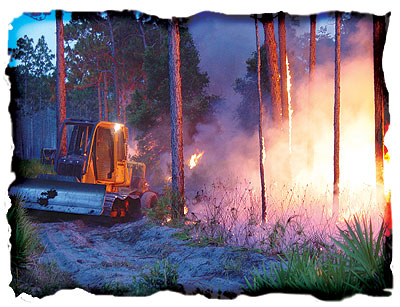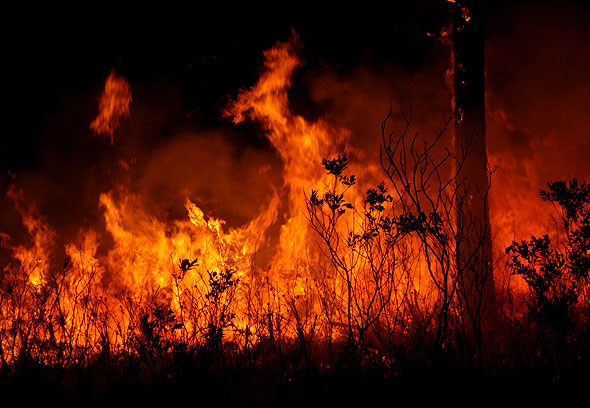
Abnormally dry conditions and the lightning that accompanies summer rains have combined to keep the District’s Land Management staff extremely busy this wildfire season, which typically runs from April through June.
Since the beginning of May through the end of July, the District and the Florida Division of Forestry (FDOF) have battled more than 40 fires on District lands, including two that were more than 400 acres each. As of mid-August, wildfires burned 2,076 acres within the District. The acreage burned would have been even greater if not for the District’s active controlled burn program.
During the previous six years, the busiest season was 2002 when wildfires burned 1,112 acres, while the slowest season was 2005 when wildfires burned just 65 acres.
The District coordinates with the FDOF in the suppression of wildfires on its lands. This coordination has become even more critical in recent years due to the increase in District land holdings, population increases along District land boundaries and the increased complexity of prescribed burning.
The FDOF is the first responder of all wildfires in the state. District staff works with four of the state’s 15 fire districts.
“Our role is to support their operations when needed and to coordinate internally to provide manpower and equipment needed,” said Kevin Love, District land manager. “At a minimum, staff and equipment from our Land Management Section will be assigned to perform ’mop-up’ duties to reduce smoke and prevent escape after initial suppression of the fire has been completed.”
Most wildfires are caused by lightning, but some are caused by people burning yard waste or by campfires that aren’t fully extinguished. In a few cases, arson is the cause. The Potts Preserve fire, which burned 417 acres in Citrus County, was attributed to human activity, since the fire occurred before the onset of the dry lightning season.

Lightning fires can be more difficult to control because multiple fires can result from a single storm, and these fires have a greater tendency to occur in remote areas. The Green Swamp West fire, which burned 550 acres, was attributed to lightning.
“For large fires, or during times of high wildfire activity, the FDOF may request heavy equipment and staff from our Operations Department as well,” said Love.
“Their primary function is to monitor the fire perimeter, push and spread smoldering debris away from the fire edge and improve or restore plow lines needed to stop the fire.”
The Starkey Wilderness Preserve, located in Pasco County, is an area that experienced frequent lightning-related fires. Lightning was the cause of 16 fires within the preserve and Serenova area, totaling approximately 670 acres. The fires ranged in size from less than an acre to 260 acres.
Will VanGelder, District senior land management specialist, who assisted the FDOF on a 260-acre wildfire at the preserve in August, says the dry conditions also contributed to the frequency.
“After 18 months of drought, the wetlands have heavy organic accumulation and are very dry,” said VanGelder. “That presents a plentiful source of fuel and smoke production, which makes these wildfires a long-term resource commitment and public nuisance.”
VanGelder is one of 10 Land Management staff members who have helped control wildfires this year, along with the support of numerous District Operations staff.
“Working in conjunction with the FDOF, we were able to minimize the environmental impact of the wildfires by cooperating with the incident commanders on each individual fire to use established trails as containment lines when possible instead of plowing through native habitats,” said VanGelder. “While this increased the amount of acreage consumed and the amount of time and effort required to control the wildfires, together we were able to preserve state conservation lands as best as possible.”
This type of coordination requires the level of trust the District and the FDOF have built over several decades of fighting fires together.
“Compared to the rest of the state, the region as a whole fared quite well this year,” said Love. “We believe that our cooperation with the dedicated staff of the FDOF and our longstanding prescribed burn program go hand-in-hand in making wildfires on District lands easier to control.”
